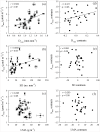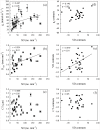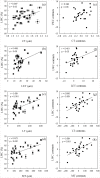Leaf photosynthetic rate of tropical ferns is evolutionarily linked to water transport capacity
- PMID: 24416265
- PMCID: PMC3886989
- DOI: 10.1371/journal.pone.0084682
Leaf photosynthetic rate of tropical ferns is evolutionarily linked to water transport capacity
Abstract
Ferns usually have relatively lower photosynthetic potential than angiosperms. However, it is unclear whether low photosynthetic potential of ferns is linked to leaf water supply. We hypothesized that there is an evolutionary association of leaf water transport capacity with photosynthesis and stomatal density in ferns. In the present study, a series of functional traits relating to leaf anatomy, hydraulics and physiology were assessed in 19 terrestrial and 11 epiphytic ferns in a common garden, and analyzed by a comparative phylogenetics method. Compared with epiphytic ferns, terrestrial ferns had higher vein density (Dvein), stomatal density (SD), stomatal conductance (gs), and photosynthetic capacity (Amax), but lower values for lower epidermal thickness (LET) and leaf thickness (LT). Across species, all traits varied significantly, but only stomatal length (SL) showed strong phylogenetic conservatism. Amax was positively correlated with Dvein and gs with and without phylogenetic corrections. SD correlated positively with Amax, Dvein and gs, with the correlation between SD and Dvein being significant after phylogenetic correction. Leaf water content showed significant correlations with LET, LT, and mesophyll thickness. Our results provide evidence that Amax of the studied ferns is linked to leaf water transport capacity, and there was an evolutionary association between water supply and demand in ferns. These findings add new insights into the evolutionary correlations among traits involving carbon and water economy in ferns.
Conflict of interest statement
Figures





Similar articles
-
Diffusional limitations explain the lower photosynthetic capacity of ferns as compared with angiosperms in a common garden study.Plant Cell Environ. 2015 Mar;38(3):448-60. doi: 10.1111/pce.12402. Epub 2014 Aug 13. Plant Cell Environ. 2015. PMID: 24995519
-
Differentiation of water-related traits in terrestrial and epiphytic Cymbidium species.Front Plant Sci. 2015 Apr 22;6:260. doi: 10.3389/fpls.2015.00260. eCollection 2015. Front Plant Sci. 2015. PMID: 25954289 Free PMC article.
-
Differential coordination of stomatal conductance, mesophyll conductance, and leaf hydraulic conductance in response to changing light across species.Plant Cell Environ. 2018 Feb;41(2):436-450. doi: 10.1111/pce.13111. Plant Cell Environ. 2018. PMID: 29220546
-
Photosynthesis Optimized across Land Plant Phylogeny.Trends Plant Sci. 2019 Oct;24(10):947-958. doi: 10.1016/j.tplants.2019.07.002. Epub 2019 Jul 27. Trends Plant Sci. 2019. PMID: 31362860 Review.
-
Relationships of Leaf Net Photosynthesis, Stomatal Conductance, and Mesophyll Conductance to Primary Metabolism: A Multispecies Meta-Analysis Approach.Plant Physiol. 2016 May;171(1):265-79. doi: 10.1104/pp.15.01660. Epub 2016 Mar 14. Plant Physiol. 2016. PMID: 26977088 Free PMC article. Review.
Cited by
-
Effects of Water Availability on the Relationships Between Hydraulic and Economic Traits in the Quercus wutaishanica Forests.Front Plant Sci. 2022 May 26;13:902509. doi: 10.3389/fpls.2022.902509. eCollection 2022. Front Plant Sci. 2022. PMID: 35720582 Free PMC article.
-
Different leaf cost-benefit strategies of ferns distributed in contrasting light habitats of sub-tropical forests.Ann Bot. 2016 Mar;117(3):497-506. doi: 10.1093/aob/mcv179. Epub 2015 Dec 18. Ann Bot. 2016. PMID: 26684751 Free PMC article.
-
Linking Auxin with Photosynthetic Rate via Leaf Venation.Plant Physiol. 2017 Sep;175(1):351-360. doi: 10.1104/pp.17.00535. Epub 2017 Jul 21. Plant Physiol. 2017. PMID: 28733387 Free PMC article.
-
Bioinspired fractal electrodes for solar energy storages.Sci Rep. 2017 Mar 31;7:45585. doi: 10.1038/srep45585. Sci Rep. 2017. PMID: 28361924 Free PMC article.
-
Exploring the mechanism of transformation in Acacia nilotica (Linn.) triggered by colchicine seed treatment.BMC Plant Biol. 2024 May 21;24(1):428. doi: 10.1186/s12870-024-05139-9. BMC Plant Biol. 2024. PMID: 38773358 Free PMC article.
References
-
- Watkins JE, Cardelús C (2012) Ferns in an angiosperm world: cretaceous radiation into the epiphytic niche and diversification on the forest floor. Int J Plant Sci 173: 695–710.
-
- Page CN (2002) Ecological strategies in fern evolution: a neopteridological overview. Rev Palaeobot Palynol 119: 1–33.
-
- Hietz P (2010) Fern adaptation to xeric environments. In: Mehltreter K, Walker LR, Sharper JM, editors. Fern Ecology. Cambridge: Cambridge University Press. pp. 140–171.
-
- Brodribb TJ, Holbrook NM, Zwieniecki MA, Palma B (2005) Leaf hydraulic capacity in ferns, conifers and angiosperms: impacts on photosynthetic maxima. New Phytol 165: 839–846. - PubMed
-
- Watkins JE, Holbrook NM, Zwieniecki MA (2010) Hydraulic properties of fern sporophytes: consequences for ecological and evolutionary diversification. Am J Bot 97: 2007–2019. - PubMed
Publication types
MeSH terms
Substances
LinkOut - more resources
Full Text Sources
Other Literature Sources

